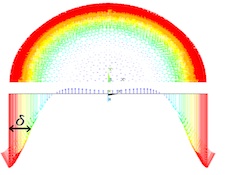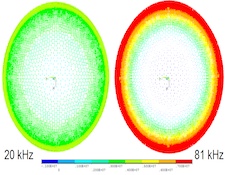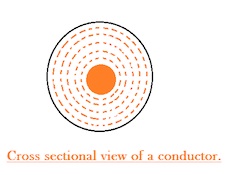It’s the time of year for saving money!
For as long as I’ve been “into” High-End audio, either as a consumer, or as a manufacturer, among the most common claims made for premium cables have been that they prevent or eliminate “Skin-effect” and “Skin-effect phase-shift”. Those are certainly catchy words – the sort of thing that marketers delight in – but do you actually know what they mean? And what effect can they have on the sound of your system? Here’s your chance to find out:
 In VERY simplified form, skin effect and its accompanying phase shift work something like this: 1.) They only apply to alternating currents (like a voice or music signal and also to AC power transmission). They DON’T apply to DC. 2.) The passage of ANY current through a wire causes an electromagnetic field to form around that wire. With an AC signal, every time the signal changes polarity, that field collapses and re-forms because of the incoming other-polarity signal. The collapse of the field creates eddy currents which force the higher frequency electrons out toward the surface of the wire (See, I told you this was simplified.) This results in a frequency-related charge density gradient throughout the wire, with the highest density at the surface of the wire and the lowest density at its center. 3.) The higher charge densities are confined to a “skin depth” related to the signal’s frequency, such that higher frequencies result in progressively thinner (and farther from the center) skin depths, and the thinner skin depths effectively reduce the volume of the conductor and result in an effective resistive gradient that slows-down electron flow to an increasingly greater degree with increasing frequency. 4.) This increase or decrease in effective speed as electrons get closer to or farther from the surface of the wire results in the (highest frequency) electrons traveling nearest the surface being “slowed-down” relative to the lower-frequency electrons traveling closer to the center of the wire, and this varying effective speed of travel through the wire, with higher frequencies traveling slower than lower ones in a frequency-related gradient is what we mean when we talk about “phase shift”. Cable proponents claim it to be deleterious to the integrity of the transmitted signal and to result – by screwing-up the relative arrival times of different elements of the same sound — in a loss of imaging and soundstaging information. The term “skin effect” derives from the “skin depth” at which the various frequencies travel within the wire or cable.
In VERY simplified form, skin effect and its accompanying phase shift work something like this: 1.) They only apply to alternating currents (like a voice or music signal and also to AC power transmission). They DON’T apply to DC. 2.) The passage of ANY current through a wire causes an electromagnetic field to form around that wire. With an AC signal, every time the signal changes polarity, that field collapses and re-forms because of the incoming other-polarity signal. The collapse of the field creates eddy currents which force the higher frequency electrons out toward the surface of the wire (See, I told you this was simplified.) This results in a frequency-related charge density gradient throughout the wire, with the highest density at the surface of the wire and the lowest density at its center. 3.) The higher charge densities are confined to a “skin depth” related to the signal’s frequency, such that higher frequencies result in progressively thinner (and farther from the center) skin depths, and the thinner skin depths effectively reduce the volume of the conductor and result in an effective resistive gradient that slows-down electron flow to an increasingly greater degree with increasing frequency. 4.) This increase or decrease in effective speed as electrons get closer to or farther from the surface of the wire results in the (highest frequency) electrons traveling nearest the surface being “slowed-down” relative to the lower-frequency electrons traveling closer to the center of the wire, and this varying effective speed of travel through the wire, with higher frequencies traveling slower than lower ones in a frequency-related gradient is what we mean when we talk about “phase shift”. Cable proponents claim it to be deleterious to the integrity of the transmitted signal and to result – by screwing-up the relative arrival times of different elements of the same sound — in a loss of imaging and soundstaging information. The term “skin effect” derives from the “skin depth” at which the various frequencies travel within the wire or cable.
Any number of ways have been used to protect against or to solve these problems. One of the oldest and simplest is “Litz” wire, which is only partly what most people think it is: For one thing, its full name is “Litzendraht” wire, which is German for wire that is “braided or stranded”. What those who have heard of it know is that each individual “primary” wire (the smallest single conductors or conductor groups in the “cable”) must be individually insulated. What they often DON’T know is that that’s not all that’s required: Instead of a normal “concentric” lay, where the individual primaries occupy fixed positions within the group (e.g. one in the center, surrounded by six, surrounded by 12, and so on) where each primary conductor always remains in the same positional relationship with all of the others, true Litz wire must also be configured (woven or braided) so that the relationship is NOT constant, and each primary conductor is constantly changing position, moving from (for example) the surface toward (in as many steps as it takes) the center of the wire group (the cable), and back out again, over and over again for the cable’s entire length.
 This doesn’t eliminate skin effect phase shift; it just “tricks” into being unimportant: If the primaries were not insulated, the “lay” of the cable (how the individual wires are arranged within it) would be irrelevant; the electrons passing through the conductors would simply jump from wire to wire, always taking the shortest or straightest path possible, and the maximum possible phase shift would apply. By insulating the individual primaries, however, this is kept from happening and the electrons are trapped, each in just one conductor, and forced to follow that conductor’s path through the cable. When this path involves moving repeatedly in and out of the group, from the surface to the center and back, what happens is repeated phase shift – sometimes forward, sometimes back – that effectively cancels itself out, leaving the signal with little phase shift or none at all.
This doesn’t eliminate skin effect phase shift; it just “tricks” into being unimportant: If the primaries were not insulated, the “lay” of the cable (how the individual wires are arranged within it) would be irrelevant; the electrons passing through the conductors would simply jump from wire to wire, always taking the shortest or straightest path possible, and the maximum possible phase shift would apply. By insulating the individual primaries, however, this is kept from happening and the electrons are trapped, each in just one conductor, and forced to follow that conductor’s path through the cable. When this path involves moving repeatedly in and out of the group, from the surface to the center and back, what happens is repeated phase shift – sometimes forward, sometimes back – that effectively cancels itself out, leaving the signal with little phase shift or none at all.
Another technique for eliminating phase shift that actually DOES eliminate it, instead of just forcing it to cancel itself out involves the “skin depth” of the frequencies to be carried, and, especially for interconnects, is the simplest thing imaginable: All you do is to make the diameter (NOT including insulation) of your individual solid-core or stranded conductors (I prefer solid-core) a little LESS than twice the skin depth of the highest frequency you want to be able to pass. [NOTE: several skin depth calculators appear on Google] That way, because the lower frequencies are going to be passed through nearer the center of the wire, anyway, and the skin depth of the highest frequency will extend all the way to (and past) the center, ALL of the frequencies are effectively traveling through ALL of the wire, and there’s no skin effect and no phase shift at all.
The problem with that method – at least for speaker cables – is that the single very thin wire it involves will offer relatively high resistance to the kind of high current levels that speakers require, and will create problems of its own, including power loss and the limiting of the amplifier’s damping factor.
 A good solution to this (possibly attributable to Audioquest’s Bill Low) is “surface-only” construction. This also uses thin, individually insulated primaries, but instead of having them in a constantly changing array, they are arranged one-layer-thick over a relatively large diameter non-conductive (dielectric) “core”. By making the individual wires, as before, less than twice the skin depth of the highest frequency to be carried, phase shift is avoided, and by using a large number of individual wires arranged in a single layer over the large core, when their electromagnetic fields unite, as they will, to form a single large field, that field is to each of the individual wires just as it would be to a single wire and, while power handling capability is increased hugely because of the greater available conductor volume, skin effect phase shift is still avoided entirely.
A good solution to this (possibly attributable to Audioquest’s Bill Low) is “surface-only” construction. This also uses thin, individually insulated primaries, but instead of having them in a constantly changing array, they are arranged one-layer-thick over a relatively large diameter non-conductive (dielectric) “core”. By making the individual wires, as before, less than twice the skin depth of the highest frequency to be carried, phase shift is avoided, and by using a large number of individual wires arranged in a single layer over the large core, when their electromagnetic fields unite, as they will, to form a single large field, that field is to each of the individual wires just as it would be to a single wire and, while power handling capability is increased hugely because of the greater available conductor volume, skin effect phase shift is still avoided entirely.
Now that you know all about skin effect phase shift and even know three techniques for minimizing or avoiding it, here’s a question for you: Compared to all of the other factors affecting a cable’s performance, how important do you think it is? Is it VERY important? Is it important, but of less importance than some other things? Or is it pure hype — just more Hi-Fi voodoo intended to sell cables, but of little real consequence? Let me know what you think.





